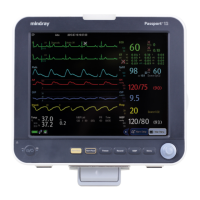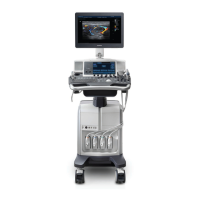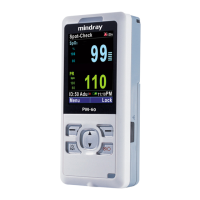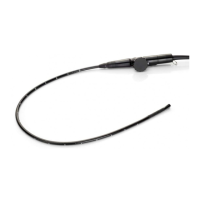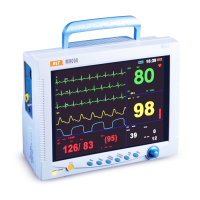Passport 12/Passport 8 Operator’s Manual 9-3
9.4.3 Abdominal Breathing
Some patients with restricted movement breathe mainly abdominally. In these cases, you may need to place the left leg
electrode on the left abdomen at the point of maximum abdominal expansion to optimise the respiratory wave.
9.4.4 Lateral Chest Expansion
In clinical applications, some patients (especially neonates) expand their chests laterally, causing a negative intrathoracic
pressure. In these cases, it is better to place the two respiration electrodes in the right midaxillary and the left lateral
chest areas at the patient’s maximum point of the breathing movement to optimise the respiratory waveform.
9.5 Choosing the Respiration Lead
In the [Resp Setup] menu, set [Resp Lead] to [I], [II] or [Auto].
9.6 Changing the Apnea Alarm Delay
The apnea alarm is a high-level alarm used to detect apneas. You can set the apnea alarm delay time after which the
monitor alarms if the patient stops breathing.
In the [Resp Setup] menu, select [Apnea Delay] and then select the appropriate setting. The [Apnea Delay] of Resp,
CO
2
, and AG module keeps consistent with each other.
9.7 Changing Resp Detection Mode
In the [Resp Setup] menu, select [Detection Mode] and then select [Auto] or [Manual].
In auto detection mode, the monitor adjusts the detection level automatically, depending on the wave height and
the presence of cardiac artifact. Note that in auto detection mode, the detection level (a dotted line) is not
displayed on the waveform.
Use auto detection mode for situations where:
The respiration rate is not close to the heart rate.
Breathing is spontaneous, with or without continuous positive airway pressure (CPAP).
Patients are ventilated, except patients with intermittent mandatory ventilation (IMV).
In manual detection mode, you adjust the dotted detection level line to the desired level by selecting [Upper Line]
or [Lower Line] and then selecting or beside them. Once set, the detection level will not adapt
automatically to different respiration depths. It is important to remember that if the depth of breathing changes,
you may need to change the detection level.
Use manual detection mode for situations where:
The respiration rate and the heart rate are close.
Patients have intermittent mandatory ventilation.
Respiration is weak. Try repositioning the electrodes to improve the signal.
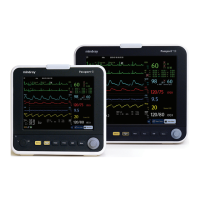
